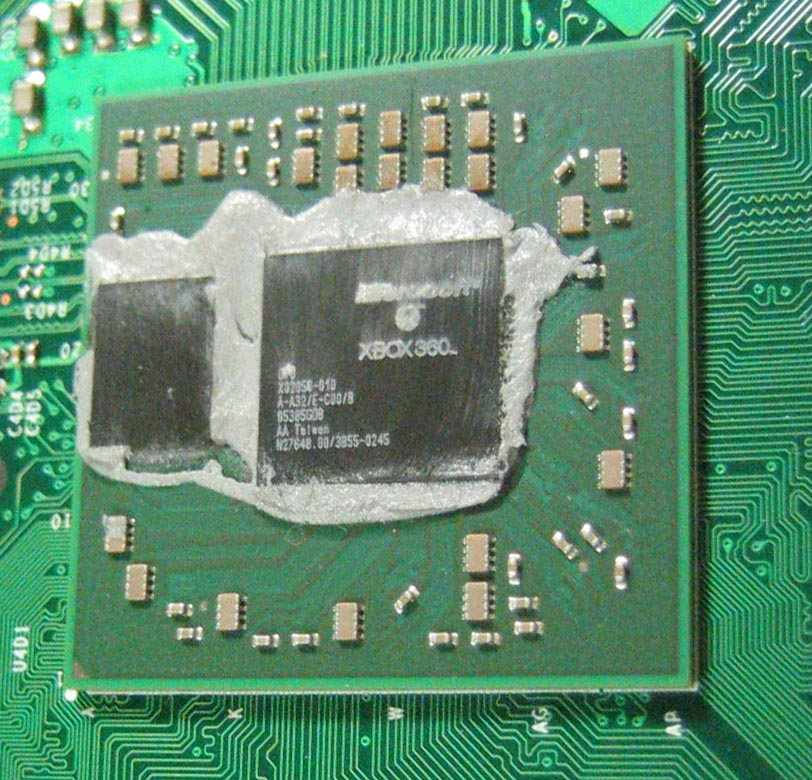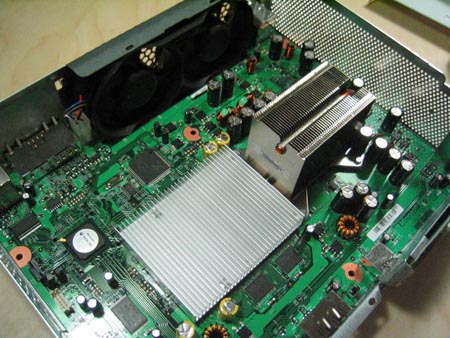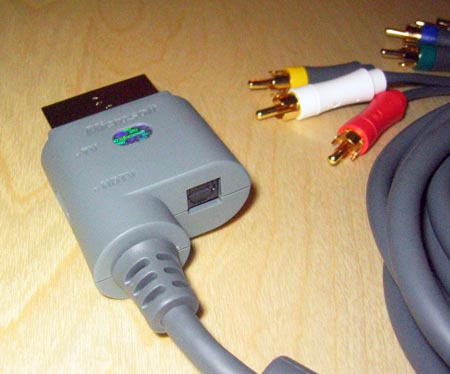Inside Microsoft's Xbox 360
by Anand Lal Shimpi, Kristopher Kubicki & Tuan Nguyen on November 16, 2005 5:09 AM EST- Posted in
- Systems
The Xbox 360 GPU
While Microsoft's focus on the CPU was efficiency, with the Xbox 360's GPU, it pulled out all the stops. Designed by ATI, Microsoft controls the IP of the GPU; meaning, Microsoft can manufacture and do what it wishes with Xenos (although we're assuming that they can't stick it on graphics cards and start selling it to the public).
The GPU also acts as a North Bridge in the system, but we'll get to that role a little later. Like the Xbox 360 CPU, we've talked about the GPU in great detail in the past, but we'll briefly go over the highlights here.
The buzzword that was around the Xbox 360 GPU's announcement was of course, its use of a Unified Shader Architecture. Modern day PC GPUs feature separate pixel and vertex shader units, which are collections of execution units and associated logic to handle pixel shader and vertex shader instructions. The Xbox 360's GPU features a single set of execution units and logic that can execute both pixel and vertex shader instructions. The benefit of a unified shader architecture is greater efficiency, as we mentioned in our original piece on it: "The unified shader architecture that ATI chose to use in their Xbox 360 GPU allows them to pack more functionality onto fewer transistors as less hardware needs to be duplicated for use in different parts of the chip and will run both vertex and shader programs on the same hardware."
There are 48 shader units in the Xbox 360 GPU, but given that we're dealing with a unified shader architecture, you can't compare that number directly to the 24 shader pipelines of the GeForce 7800 GTX for example. We roughly estimated the shader processing power of the Xbox 360 GPU to be similar to that of a 24-pipeline ATI R420 GPU.
The other big feature of the Xbox 360 GPU is its dual die construction. The 332 million transistor GPU is split into two separate dice, the larger of which looks like a conventional GPU, and then a smaller die (aka daughter die) that is a 10MB block of embedded DRAM (eDRAM) combined with the hardware necessary for z and stencil operations, color and alpha processing, and anti aliasing. The daughter die connects to the larger die via a 32GB/s on-package interconnect.
The logic and embedded DRAM on the daughter die is what allows the Xbox 360 GPU to essentially offer "free" anti-aliasing, which Microsoft enforces through requiring developers to support a minimum of 2X AA in all Xbox 360 titles. Although we were originally told back at E3 that all Xbox 360 titles would support 4X AA, it seems that the statement has since been revised to 2X or 4X AA. We're not certain why the change was made, as 2X and 4X are both effectively "free" on the GPU, but there may be something we're missing.
On a smaller manufacturing process, the dice could be unified, as they are only separated right now in order to improve yields. Impressively enough, the GPU is cooled by a fairly low profile heatsink, with the two rear case fans in the Xbox 360 providing all the airflow over the heatsink's fins.
For a more in-depth look at the Xbox 360's GPU, head over to our original coverage of the architecture back at E3.
Backwards Compatibility
With a completely different CPU ISA (Instruction Set Architecture) and a GPU from a different manufacturer the Xbox 360 is a very different beast than the original Xbox, thus backwards compatibility had to be done via software emulation.
Microsoft recently announced the 212 original Xbox titles that would be backwards compatible on the Xbox 360 at launch, you can view the entire list here. In order to take advantage of the backwards compatibility you need to have the removable hard drive attached to the Xbox, as a software patch will have to be downloaded from Microsoft's servers. The download process will happen automatically and you will be alerted if the title you're attempting to play does not yet have a patch available for it.
HDTV Support
With the Xbox 360, Microsoft hopes to usher in the era of HD gaming, first and foremost by requiring all Xbox 360 games to support 720p (1280 x 720). Unfortunately, we have yet to hear from Microsoft if this means that all games must be internally rendered at 1280 x 720 or if they can be rendered at a lower resolution and upscaled later on. There have been discussions involving at least one Xbox 360 game (Project Gotham Racing 3), rendering internally at a lower resolution and having the Xbox 360's TV encoder upscale it to 720p.
You don't have to have a HDTV, but obviously owning one will give you better overall image quality. The Xbox 360 supports all of the most popular video formats: 480i, 480p, 720p and 1080i.
There is no out of box DVI or HDMI support, nor is there any Microsoft support for either of those video interface standards at this time, although Microsoft has indicated that they may offer HDMI support when it makes sense to. There is, however, an optical output, but the cable is not included.
If you don't have a HDTV but you have a VGA monitor that you'd like to use, Microsoft does offer a VGA cable that will allow you to connect your Xbox 360 to a VGA monitor. If you don't have a HDTV or a monitor but still want a higher quality output, Microsoft also offers a S-Video AV cable.













91 Comments
View All Comments
fuzzynavel - Wednesday, November 16, 2005 - link
Thanks for the article....shame slash-dot has killed your bandwidth!!Seems like a good point about overheating...maybe worth waiting till 65nm chips start showing up...won't get one in the UK till way after christmas anyway!!(haven't pre-ordered)
Face27 - Wednesday, November 16, 2005 - link
Is it my connection or is anandtech being really slow, its not loading any of the pictures which is what I wanna look at. I'm guessing this is quite a popular article.zech - Wednesday, November 16, 2005 - link
The article was slashdotted:http://games.slashdot.org/games/05/11/16/1432205.s...">http://games.slashdot.org/games/05/11/1...5.shtml?...
Anandtech's servers aren't handling this /. very well. But this is one of the first Xbox360 interal reviews (in a PC-hardware sort of fashion), so I'm sure every Xbox360 forum out there is posting links to it.
ItsOnlyMonday - Wednesday, November 16, 2005 - link
Yes, these pictures are on multiple forums, somee even lack proper credits.. :-\gamigin - Wednesday, November 16, 2005 - link
[quote]game developers shouldn't run into capacity limitations on Xbox 360 discs anytime soon
[/quote]
Prominent game developers disagree
From "http://www.eurogamer.net/article.php?article_id=56...">http://www.eurogamer.net/article.php?article_id=56.... Note that this interview was before the next gen console debate in 2004.
[quote]
The danger is currently the storage medium (DVD), and one we thing we’re all praying for in the next round of hardware is that they don’t just go, ‘It’s DVD again’. We’ve done some clever stuff with compressing it, but we were virtually full on the disc with Vice City – this time we’re overfilling the disc to the max.”
[/quote]
quanta - Wednesday, November 16, 2005 - link
If the developers worry about that much on not enough space to store sound samples, they should have invested on text to speech technology a long time ago, instead of relying on prerecorded sample. Unlike the cheesy Macintalk TTS in the 1980s, modern TTS can accurately simulate human speeches, even the emotional tones. Hey, Ananova uses it, does it not? That way the developers don't even have to worry about rehiring dead/retired/on-strike workers doing voices for games based on century-old movies!gamigin - Wednesday, November 16, 2005 - link
Voice synthesis is great but it's really not at the point of replacing voice actors for dramatic games. Can you imagine watching a movie with the voices of your favorite actor dubbed in by a computer? Not quite the same.Also, it's more than just voice overs; a lot of space is used for graphics, models, textures, landscapes, animation data, sound effects, and music.
Most current games don't need more capacity than standard DVD at the moment but some definitely do and others could at least take advantage of it.
quanta - Wednesday, November 16, 2005 - link
Actually, the emotionalal aspect of TTS is already been done by http://www.computing.dundee.ac.uk/staff/irmurray/s...">various people. In fact, many commercial grade TTS software that supports http://www.w3.org/TR/speech-synthesis/">SSML already able generate emotionally sounding voices. It's not Microsoft's fault that game developers don't try to use/refine the existing TTS engines to make them usable for voice acting applications.Xenoterranos - Thursday, November 17, 2005 - link
Ywah, sure, but can you get a computer to do a dead-on Ray Liotta? I think not my friends, I think not!quanta - Tuesday, December 6, 2005 - link
Why don't you try it first before commenting? You can find some demos on http://www.nuance.com/realspeak/rvoice/english.asp">Nuance rVoice's site. Depending on the title, the TTS voices sound better than the real live voices in some games.